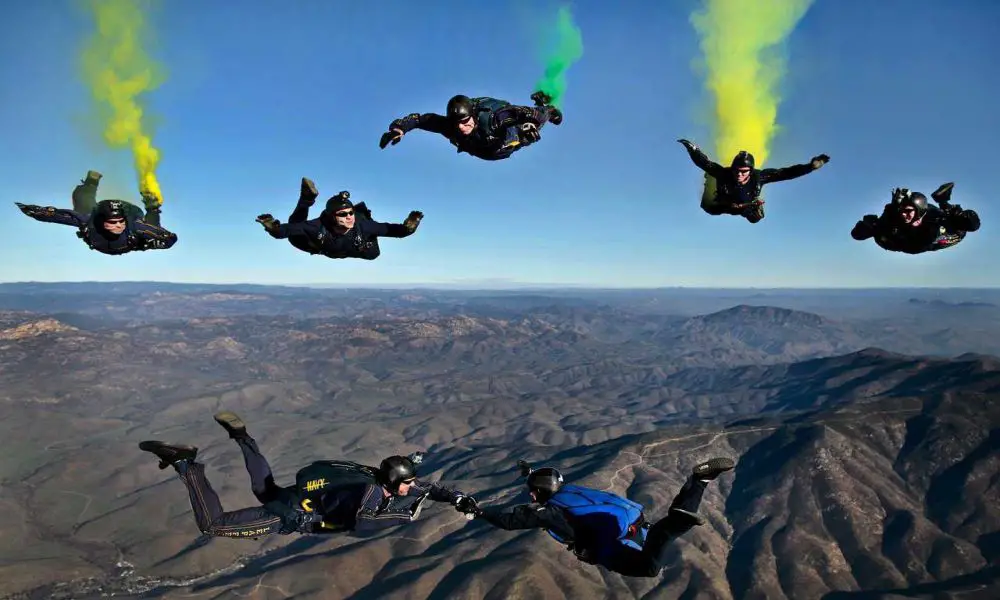Skydiving is a popular activity, yet few are brave enough to try it. This article changes your prejudice about getting a skydiving session by answering all the relevant questions that beginners like you have.
Have you ever tried skydiving before? Well, you should. The excitement and joy that rides on amusement parks are nothing compared to the excitement and joy that it brings. Each skydiving session literally and figuratively takes you to new heights.
A slight mistake can lead to disastrous results while skydiving. That’s why it’s perfectly understandable if you’re divided about booking your first session.
That’s why this article is here. This article assures you that nothing wrong will happen out of doing it by answering all of the answers that you have as a beginner.
Skydiving For Beginners
Can I Skydive by Myself for the First Time?
Yeah, sure, you can skydive by yourself for the first time. The requisites are very simple, really. You just need to get a plane rental and have your own parachute.
Also, before going, realize that a solo dive is extremely expensive and dangerous compared to skydiving with a group that an instructor oversees
But if you really have the money to pay for the plane and the guts to challenge death, then you’re all set! Jump now and feel the wind on your space. By the way, don’t come asking for help if officer James imprisons you afterward.
So why put you in jail? Assuming that you managed to rent a plane but you didn’t get any skydiving certificates, solo-diving infringes specific sections and clauses of the Parachute Operations in Designated Airspace.
But infringing the law above isn’t the only problem. If you attempt to solo dive without proper training, no pilot will ever offer you a ride, no matter how much you pay. They will lose their license if they choose to do otherwise.
To make everything clear, you can skydive on your own. However, you may only do so if you have proper training, the money for plane rental, and the essential gears.
How Much Does It Cost to Learn to Skydive?
You have two options for skydiving lessons – AFF accelerated lessons and an A-license course. Enroll for the AFF if you want to learn skydiving but don’t have plans on making it a hobby. On the other hand, register for the A-license course if you want to become an expert.
The A-license course costs between $2000 – $3000. On the other hand, the pricing of the AFF costs between $200 – $300 depending on the jump category.
Also, the AFF accelerated lesson comes in the form of a package. Its package version costs $1000 – $2000. Though expensive, you might like the AFF package better because it offers 7 – 25 jumps.
To avoid confusion, know that you have to enroll in the AFF before enrolling for the A-license course. The AFF is more like a preparatory tutorial for skydiving, while the A-license is an advanced training if you wish to learn the ins and outs of skydiving.
How High Is the Average Skydive?
The average skydiving height is 10,000 to 13,500 feet. These are the maximum heights where you may jump from with an AFF accelerated lessons certificate.
You may jump from higher altitudes if you have the A-license course certificate and other advanced skydiving certificates. As an expert, you can dive from an altitude of 15,000 feet – 30,00o feet
In connection, jumping at altitudes higher than 13,000 requires the use of oxygen tanks because breathing with the lungs will be impossible.
At What Height Do You Open the Parachute?
The instructor will decide when to open the parachute. With that said, don’t panic and decide to open the chute on your own if you’re a beginner.
Commonly, the instructor, who accompanies you during the skydive, pulls the chute string at 6,000 feet so that it’s fully opened by the time you descend at 5,000 feet.
How Fast Do You Fall When You Skydive?
Pointing out a specific speed when you skydive is impossible since it’s dependent on numerous factors such as the weather condition, your build, and your current weight. With that said, this section only provides you with estimates.
These are the speed of your freefall based on how much you weigh:
- 60 kilos – you will fall at 110.8 mph
- 70 kilos – you will fall at 119.6 mph
- 80 kilos – you will fall at 125 mph
- 90 kilos – you will fall at 135.7 mph
- 100 kilos – you will fall at 143 mph
How Long Does a Skydiving Session Last?
A skydiving session feels long but actually lasts quickly. Depending on the altitude, you will enjoy the dive for 30 seconds up to 1 minute.
However, don’t be disheartened. Such durations are for freefall only. If you take your time on the air with the parachute into account, skydiving lasts for at least 5-10 minutes.
In Case of Accidents, at How Much Force Do I Hit the Ground?
The rate at which you fall after a skydive is reduced by more than half if you hit the ground with a parachute. This isn’t much of a concern. What’s more wonder about is how much force you hit the ground in case the parachute doesn’t work. For the specific figures, take a look at this simple table:
- If you weigh 60 kilos and are falling at 110.8 mph, you will hit the ground at 413, 663 pound-force, which is similar to being hit with a 206-ton object
- if you weigh 70 kilos and are falling at 119.6 mph, you will hit the ground at 481,981 pound-force, which is equal to being hit with a 241-ton object
- If you weigh 80 kilos and are falling at 125 moh, you will hit the ground at 526-487 pound-force, which is equal to being hit with a 263-ton object
- If you weigh 90 kilos and are falling at 135.7 mph, you will hit the ground at 620, 479 pound-force, which is equal to being hit with a 310-ton object
How Dangerous Is Skydiving?
Skydiving is very dangerous, and that’s why you need schooling before doing it. While doing it, you’re at the mercy of gravity, and only the instructor can save you if something wrong happens.
You don’t have to very afraid about skydiving for the first time even though it’s dangerous. An instructor will be with you, and he or she will ensure that you jump, position yourself, and deploy the parachute correctly.
Data shows that only 1 in 100,000 thousand people die or experience accidents when skydiving. In connection, only 11 fatal skydiving-related accidents happened in 2020. A year before that, there are only 15 fatal skydiving accidents.
So sky diving isn’t dangerous. It’s a recreational activity that’s a bit risky but doesn’t compromise your well-being
What Can Go Wrong In Sky Diving?
While sky diving, you might make some amateur mistakes. If you’re up in the air, these amateur mistakes can kill you or get you bedridden for life. Here are some of them.
Pulling The Chute Too Early
You might pull the chute too early out of nervousness. If pulled too early, the chute won’t open since the surrounding air is too thin for it to catch. Another dangerous scenario is, when pulled early, the plane’s propellers might catch the chute.
Pulling the Chute Late
If not early, then the instructor might pull the chute too late due to malfunctions. A fatal consequence of this is the so-called hook turn, where the opening of the chute violently shakes you, thereby resulting in injuries.
Chute Opening by Itself
Sometimes, the chute can get defective and open up by itself, resulting in the above accidents. This is something that’s very dangerous because it can forcefully drag you out of the plane or cause you to fall hard on the ground.
Freefall Collisions
This is an accident that might happen if you’re skydiving with a group. The causes of this are the windy condition of the sky and the awkward freefall position of skydivers.
Plane Crash
The chances of a plane crash happening aren’t impossible. As a matter of fact, a part of the skydiving training teaches you what to do in case this happens.
Do You Experience Stomach Drops When Skydiving?
Stomach drops happen when you’re riding something that’s too fast for your body to adapt, say the sudden hop of the car on the bump or a roller coaster’s movement. Stomach drops don’t happen when you’re skydiving. This is because the plane will help your body adapt to the speed of the freefall.
Skydiving Equipment You Need as a Beginner
Parachute
The parachute prevents you from falling hard on the ground. It’s attached to the harness. There are two chutes in reality, the main chute and the pilot chute. The pilot chute is a small chute that catches air so that the main chute can open.
Harness
The harness is the equipment that holds the main chute and the pilot chute. It also ensures that the main chute stays attached to your body after it’s opened so that you don’t fall hard on the ground.
Helmet
You will wear a helmet inside the plane before freefall. The wearing of a helmet serves as a precautionary measure in case something fatal happens during flight.
Goggles (Optional)
The goggles protect your eyes from the air while freefalling. For some, the speed of the wind can affect vision and may even hurt it.
Dive Smoke (Optional)
A dive smoke makes the skydiving flashy by leaving a trail as you fall. Professional skydivers use this for their grouped skydiving sessions.
Conclusion
Skydiving is a fun activity. However, it’s not very fun if you put yourself at risk. That’s why get skydiving lessons before freefalling from the sky.
You may only skydive by yourself if you have the necessary certificates to testify to your qualification. Understand that authorities may imprison you if you solo dive as an untrained amateur.
In sky diving, it’s very important to be conscious about what you’re doing with the parachute. It’s your only defense against instant death, so be very mindful when deploying it.
Share this article if it greatly helped. Hoped that it answered your questions and removed your fear about getting your first skydiving session.

